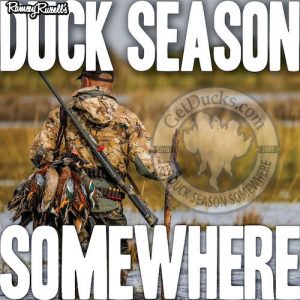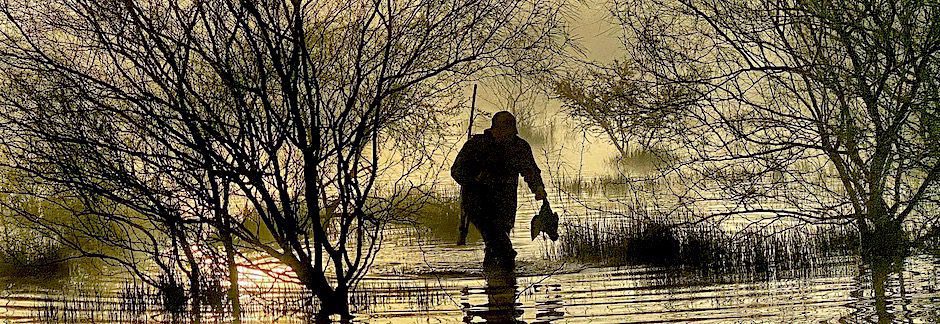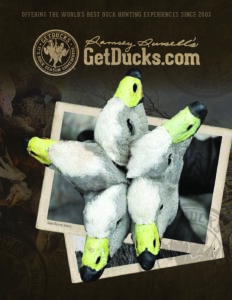MOJO’S Duck Season Somewhere Podcast
EP 531. Father-Son Hunting Trip of a Lifetime

Ramsey hears what fathers and sons most enjoyed about their bucket-list hunt in Argentina for ducks, doves, pigeons and more. Their answers might surprise you. And how the heck did Ramsey go from favorite nephew to 5th-favorite of only four?! Tune in to find out. Whether curious about what it’s all about or thinking about a bucket-list hunt yourself, you’ll probably enjoy these candid perspectives.
EP 530. SPECIAL Waterfowl Migration Forecast

What kind of migration might you expect to see this duck season? FowlWeather Podcast host, Michael Schummer, returns to give us the lowdown on this year’s migration forecast, explaining how and why his forecast indices were developed, important cues to monitor, how to stay updated weekly, and relevance to both anxious duck hunters and to continuing science-based, hunter-oriented waterfowl management. By the time this special episode airs, the US waterfowl hunting season will be ongoing nearly nationwide, and this conversation offers food for thought while awaiting waterfowl over your decoys!
EP 529. For Seventy-One Years a Duck Hunter (Part 2)

PART 2—For 71 years, Worth Matthewson of Eugene, Oregon, has chased waterfowl and other gamebirds throughout North America and worldwide. A genuine side-by-side and big-bore aficionado, he’s authored many books and is widely recognized as an authority in waterfowling history, having accumulated so many stories it takes 2 episodes to scratch the surface good. With unrivaled perspective, Matthewson covers many topics to include an early interest in birds, memorable hunting locations, influences, favorite species and the ones that elude him still, collecting big-bore and traditional shotguns, recovering a favorite shotgun 2 years after losing it overboard, a tragic hunt on Tillamook Bay, favorite and most challenging gamebird species, punt gunning, hunting worldwide with his hunting partner wife, sportsmanship and bag limits, old-school and modern-day waterfowl hunting methods, best hunter ever met, band-tail pigeon hunting, selling off his collection for a good cause, changes he’s witnessed, things he’d maybe change, hopes and concerns for the future of waterfowling, and much more.
EP 528. For Seventy-One Years a Duck Hunter (Part 1)

PART 1—For 71 years, Worth Matthewson of Eugene, Oregon, has chased waterfowl and other game birds throughout North America and worldwide. A genuine side-by-side and big-bore aficionado, he’s authored many books and is widely recognized as an authority in waterfowling history, having accumulated so many stories it takes 2 episodes to scratch the surface good. With unrivaled perspective, Matthewson covers many topics to include an early interest in birds, memorable hunting locations, influences, favorite species and the ones that elude him still, collecting big-bore and traditional shotguns, recovering a favorite shotgun 2 years after losing it overboard, a tragic hunt on Tillamook Bay, favorite and most challenging game bird species, punt gunning, hunting worldwide with his hunting partner wife, sportsmanship and bag limits, old-school and modern-day waterfowl hunting methods, best hunter ever met, band-tail pigeon hunting, selling off his collection for a good cause, changes he’s witnessed, things he’d maybe change, hopes and concerns for the future of waterfowling, and much more.
EP 527. Legendary Coca-Cola Woods and Beyond

Born-and-raised Arkansas native Rusty Creasey was manager and head guide at legendary Coca-Cola Woods Duck Club for 20 years, continuing the legacy of his uncle Harvey, who managed the property for the 40 years prior. Recognized for his learned-from-a-lifetime-doing-it expertise, Rusty shares his thoughts on Arkansas flooded timber hunting, thoughtfully covering the topics of growing up in rural Arkansas, life lessons and important influences, a lifetime spent in Coca Cola woods, habitat conditions and management, hunting “local” versus “migrator” mallards, the do-and-don’t rules hunting flooded timber effectively, archery hunting green heads, and why for the first time since 1958 there won’t be a Creasey family member in the iconic Coca Cola woods this season. Like watching mallards magically spilling over the tree tops and splashing at your feet, it’s a memorable conversation.
EP 526. Delta Waterfowl Texas

Regional Director, Ryan Watson gives us a great then-and-now overview of Delta Waterfowl and how they fit in the grand scheme of conservation both locally and continentally. We talk about the origins of Delta waterfowl, predator management, accomplishing the Million Duck initiative, hen houses, nest boxes, working with other conservation orgs, volunteering and, importantly, how chapters can put conservation on the ground locally.
EP 525. There’s Something About Sandhill Cranes

One of North America’s most unique webless gamebirds, sandhill cranes are oftentimes referred to as “ribeyes of the sky” and included among popular waterfowl slam listings. Alabama biologist Courtnay Conring has studied them extensively and hunted them seriously. We do a deep dive into sandhill cranes to include migrating and non-migrating populations, which populations are hunted and protected, differences between greater and lesser sandhill cranes, habitat, diet, habitat conservation, new hunting opportunities, cooking and how-to sandhill crane hunting techniques. Whether collecting groceries, trophies or experiences, most North American waterfowl hunters may likely find themselves chasing sandhill cranes and will appreciate this informative discussion.
EP 524. On Delivering First-class Hunting Lodge Hospitality

You’ve traveled far away from home for a dream hunt and–all things equal, some days better than others–waterfowl are a constant. It’s the everything else that really makes a huge difference. Which is why on the heels of another epic 3-day waterfowl hunt at Prairie Limits Outfitters, I met with Brian Cramer to gain insight on “controlling the controllables” and delivering superior, made-to-feel-at-home hospitality. Because too few do it as well.
Related Links:
EP 523. Canadian Duck Camp Cooking

Hunting trips are no place to lose a few pounds. To the contrary, you should be ready to loosen your belt, eat like kings, enjoy. Which is exactly why Chef DJ is among the most popular people at Prairie Limits Outfitters in Saskatchewan, why his specialties are in high demand by returning guests, and why everyone gravitates towards his kitchen throughout the day. Sharing some hallmark recipes along the way, Chef DJ talks about growing up in rural Canada, his interest in cooking, learning to cook for big groups, and how hunting benefits local communities.
Related Links:
EP 522. Manitoba Young Guns

What’s it like growing up a young, avid waterfowler in the north-of-the-border Land of Plenty? How’s it similar to the USA–and how’s it different? What might you wish be different, and for what might you be most thankful? In a random turn of events, Ramsey falls in with 3 die-hard, young-gun Manitoba hunters who show him what it’s like growing up a goose hunter these days in Canada and share some interesting and downright surprising insights. And to think it all started with a shiny new moped in a gravel parking lot! Really good stuff.








